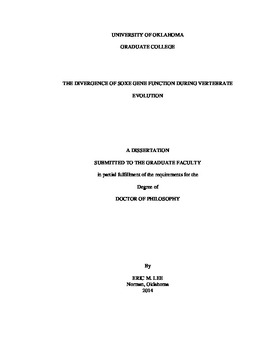| dc.description.abstract | Evolutionary developmental biology (evo-devo) is the study of how developmental mechanisms that shape organisms have changed through evolutionary time. A central question in evo-devo asks how early vertebrates may have transitioned from sedentary filter feeding to active predatory lifestyles during early Cambria. Neural crest cells (NCCs) are a vertebrate innovation that has been credited for facilitating this transition and therefore have long been of interest to evolutionary developmental biologists. NCCs have also been regarded as a ‘fourth germ-layer” due to the wide array of cell types they can generate, such as jaws. Lampreys are primitively jawless vertebrates (agnathans) that possess NCCs and occupy a critical position at the base of vertebrate phylogeny with fossils dating back to 360 million years ago. Additionally, advancements in molecular biology have engendered a resurgence of interest in lamprey research in recent years. Zebrafish are basal jawed vertebrates (gnathostomes) and straddle the agnathan-gnathostome boundary. Zebrafish research has continued to gain momentum over the years, becoming a powerful vertebrate model for developmental studies alongside mice, Xenopus, and chick. This dissertation work combines the power of zebrafish genetics and the critical phylogenetic position of lampreys to study how regulation of neural crest development has evolved by changes in the functions of SoxE transcription factors across the agnathan-gnathostome boundary. In Chapter One, I provide the context for how research on lampreys can inform our understanding of vertebrate evolution. I also lay out a rationale for using lampreys and zebrafish to study the evolution of neural crest developmental mechanisms.
The regulation of neural crest development is a complex system composed of a gene regulatory network that involves signaling molecules, transcription factors, and effector genes. SoxE genes (Sox8, Sox9, and Sox10) originated from a single ancestral SoxE through gene duplication and encode transcription factors that regulate neural crest specification, survival during migration, and activation of effector genes to initiate differentiation of multiple cell types. The sea lamprey (Petromyzon marinus) possesses three SoxE genes (PmSoxE1, PmSoxE2, and PmSoxE3), of which only PmSoxE2 is required for pigment cell and peripheral neuron development. In Chapter Two, I show that PmSoxE2 is the likely agnathan ortholog of Sox10 and also retains functional conservation with zebrafish (Danio rerio) Drsox10. I show also that the regulatory role by a SoxE gene may be different between lampreys and zebrafish in the context of cartilage differentiation. While Sox9 regulates differentiation of cartilage in gnathostome vertebrates, this function was acquired in lampreys by the lamprey specific SoxE homolog, PmSoxE1, instead of the lamprey Sox9 ortholog, PmSoxE3. Taken together, these results suggest that Sox10/SoxE2 diverged from Sox9 early in vertebrate evolution and these genes now possess disparate functions and are specialized for lineage specific activities during neural crest development. However, it remains unclear what confers these different abilities to closely related SoxE paralogs. In Chapter Three, I have performed an in-depth comparison between zebrafish Drsox10 and lamprey SoxE protein domains using chimeric PmSoxE1, PmSoxE2, and PmSoxE3 constructs that feature domains recombined from among different SoxE paralogs. The differential ability of these chimeric constructs to induce melanogenesis, neurogenesis, and chondrogenesis in zebrafish Drsox10 and Drsox9a mutants was compared with the abilities of full-length lamprey SoxE constructs. The results show that the composition of the C-terminal transactivation (TA) domain of SoxE proteins can have a significant impact in their abilities to induce melanogenesis and neurogenesis. However, protein regions outside of the TA domain may also have important roles in the regulation of neural crest development. Furthermore, our results suggest that the inability of PmSoxE2 to regulate cartilage differentiation is likely due to protein regions outside of its TA domain. We speculate that multiple SoxE protein domains may work in concert to fully activate specific downstream target effector genes. Additional studies incorporating precise amino acid changes in chimeric variants will be important for understanding how SoxE protein domains may have evolved differently across the agnathan-gnathostome boundary to acquire neural crest lineage-specific activities. | en_US |
